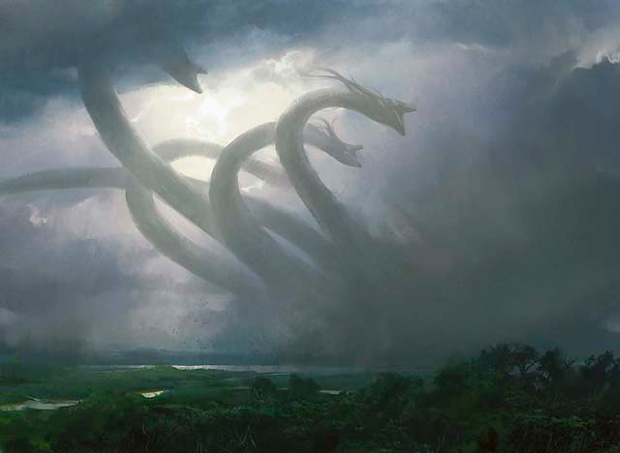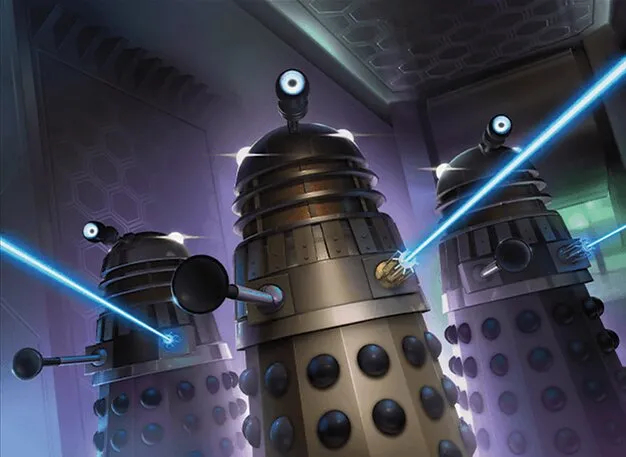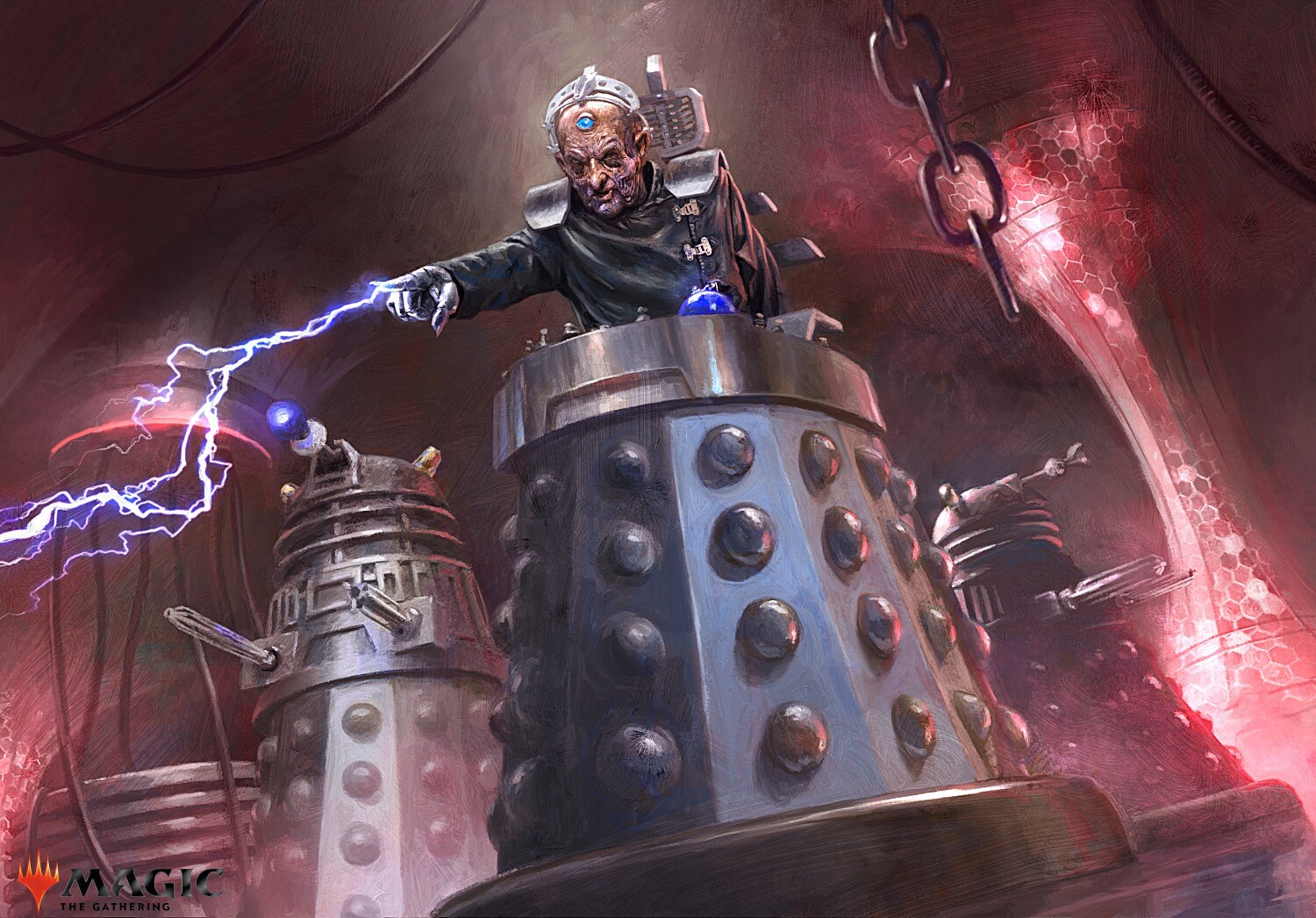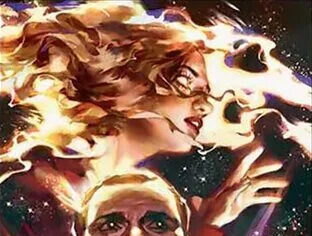The Pinnacle: Designing Monstrosities (Part 2)
Top creatures in Magic the Gathering
By: Daniel Clayton – The Will of the Floral Spuzzem (Link to part 1)Today I want to talk about some of the most utilized creatures in the game as a whole and what makes them good. I’ll also try to pull some decks in and show just how good they are with their performance throughout time since their printing. Some of the cards on this list are a part of the most expensive cards in the game club while others are not quite as flashy. My requirement is that they are creatures and they have had some type of impact on the game at some point. While I will try my best to put the best creatures in the game on my list I am only human and as such make mistakes so I apologize in advance if your favorite did not make it on my list. As this is a type of card versus a specific card I figured I would drop them out in a top 6 list going from number 6 to number 1. I’ll also be pulling in some honorable mentions from throughout the years. In the previous article we started talking about creatures numbers 6 through 4 and some decks that they exist in that have done fairly well in over the years. To give a little review, at number 6 we had our super mana-producing creatures Rofellos, Llanowar Emissary and Metalworker with a spotlight on a powerful and fast deck: Metalworker (MUD). Sitting at number 5 we went over our unique creatures Arcbound Ravager and True-Name Nemesis, as well as the uniquely difficult decks that they exist in. Finally, sitting at number 4 is our combo creatures Kiki-Jiki, Mirror Breaker and Stoneforge Mystic, along with the powerful modern creation Kiki-Angel deck (My name for it… I think). In this article we’ll hit numbers 3 through 1 and try to find out what the best creature in the game is… well the best one in my opinion anyway.
Honorable Mention
In the early days of Magic they printed a card called Oath of Druids and a whole deck was designed around it. The deck became a huge contender long after it was printed, the major idea of the deck was your opponent put out one creature then you could cheat the most powerful creature in your deck into play. This card and others like it made the deck a huge challenge for its time. One of the major fuels for the deck was Forbidden Orchard, a Legendary Land from Kamigawa that tapped for one mana of any color and put a 1/1 colorless spirit token into play under your opponent’s control. This card exists as part of a triumvirate of the most powerful creatures in the game. With protection from everything and the creature being a 10/10 it’s almost always an unstoppable 2 turn clock.
Deck:
So the major idea for this deck is to get Oath online and then win by taking infinite turns with Time Vault, and swinging for victory with the Progenitus. This deck is almost card for card the same deck that was created by Starcity games a while ago, with a couple differences to suit my own tastes; the two differences are the adding in of Progenitus and the adding of Tezzeret. Tezzeret combined with Time Vault is basically a win condition on its own; it acts as a replacement for Voltaic Key and even does it better than Voltaic Key sometimes; it can be put into exile to activate Force of Will; and his final creates attackers if you don’t have any others. I put in Progenitus, because if I can get it online on my turn and I’ve got infinite turns it’s almost impossible to stop. If you do decide to get into Vintage and build this deck there just note that it typically gets beaten out by more true to name control decks for their ability to counter spells and abilities.
Number 3
Emrakul, the Aeons Torn & Blightsteel Colossus
Clocking in at number 3 are the other members of the triumvirate, and also the 2 strongest creatures in the game, these cards are so powerful in fact that many decks that run these two creatures don’t typically run too many other win conditions. Emrakul is so powerful for all of the things that he has; the strongest creature in the game at 15/15, he can’t be countered, he grants you an extra turn when he’s cast, he has flying, protection from colored spells and most importantly he has annihilator 6 (this means your opponent sacrifices 6 permanents every single time he attacks). To show you how good this creature is it is the creature that has replaced Progenitus in almost every deck that Progenitus has held sway over in the past. At 15 power it wins the game in two swings and can take down just about anything that blocks it, and at 15 toughness there aren’t many things that can take it down in a fair fight. Flying gives this card a fair amount of evasion, and the protection from colored spells gives him protection from most of the removal that he has to deal with; the ability to take an extra turn means that this card has an ability which is strictly better than haste. The real ability that wins games is none of these however, Annihilator 6 is the knife that ends the games in most situations; it is typically just too hard to recover from sacrificing 6 permanents and blocking with one for you to fight against this card in most situations. On the other side of the bench is one of the only creatures that has an ability to deal with Emrakul reliably, Blightsteel Colossus; this is the other member of the triumvirate and is my personal favorite. He is big, he is bad and he is the card that ran to replace Darksteel Colossus. He is an 11/11 for 12 with Trample and Infect; he is indestructible and if by some off chance he would be put in a graveyard, he is shuffled back into his owner’s deck instead. This is one of those cards that typically wins the game the first turn he’s out, unless your opponent finds an answer the game is over before they can find one. These are the two most powerful creatures in the entire game based on brute strength. Now if we compared how good cards are by how well they are able to defeat other cards of the same type then these two would be the most powerful cards in the game hands down, but they don’t do much for you early to mid-game if you don’t trick them out leading to their rating of 3 instead of 1. As for a deck list for these two look up the last article to see Blightsteel Colossus in the Metalworker deck and Emrakul, the Aeons Torn easily takes over Progenitus’s spot in the Oath of Druids variant.
Honorable Mention
Dark Confidant and Snapcaster Mage
Now, I’m sure there are some of you wondering why these two cards did not make the list, surely there are cards on this list that are less than these two creatures and the short answer is debatably yes there are worse cards on this list than these 2 cards, but I wanted to show diversity of creatures and different scales on which they could be graded, essentially where the essence of the most powerful creatures in the game fit when compared to the essence of the other most powerful creatures in the game, as for why these 2 cards aren’t taking up the spot for their creature essence type, that will become apparent when I reveal our number 2 card; the overall theme of this card is card advantage. These two cards have become staples in just about every format they are legal in, in just about every deck that has their color, and for good reason.
Number 2
People have been calling for this card to get banned almost since its printing as many people complain that it’s just too powerful. The card is beautiful and simple, but a post-editing R&D pulled the card away from too broken card-hood; it’s a 7/7 Flyer with Lifelink that you can pay 7 life to draw 7 cards, so obviously it costs 7 to go with the theme? Wrong, it costs 8 mana probably to keep it from once again being too broken. But does increasing its mana cost make the card unbroken? According to many of the players who have been faced down by the Demon not by a long shot. With tons of ways to cheat this into play the card may be facing the ban-hammer one day very soon, but for now it sits in a very powerful spot at number 2 on our list. The traditional list for Griselbrand involves ways to cheat it out and runs alongside the ever-powerful Emrakul, and a lot of the time people would much rather have a Griselbrand rather than an Emrakul. The reason for that is the draw ability which lets you draw almost a quarter of your deck in just a turn, it costs you some life, but the trade-off is easily worth it, especially when you consider he regains you the life you lost for drawing 7 cards. This card is so strong it’s not even funny. Plus when you consider the fact that in the 7 cards you draw another Griselbrand shouldn’t be too far off from feasible in just your first try. The flavor text on the card seems fitting for not only his opponents in the story but also for any player who’s had the misfortune of being faced down by this demonic power house. For this deck I look back to 2013 and look at a deck that took 1st place Sneak and Show.
Sneak and Show Legacy Decklist
The major game plan of the deck is to get a Sneak Attack or Show and Tell online and put an Emrakul onto the field and win the game from there. The deck may pretty much be a one-trick pony, but who needs other tricks if it works? The deck is highly competitive and the inclusion of Griselbrand makes the deck much, much faster. Everything in the deck, Griselbrand included, is used either to get pieces for your combo, to defend your combo or to get your combo out sooner. It is a very aggressive and powerful deck.
To Recap
I’m pretty sure at this point just about everyone can think of at least one of the cards at our number one spot, but let’s go through our list one more time in case you missed one. At number 6, we have Rofellos and Metalworker or just mana producing creatures in general, being able to ramp is a powerful ability and these two seem to do it better than anyone else, they may not get you there by themselves but they’ll provide the fuel to do it. At number 5, we have Arcbound Ravager and True-Name Nemesis, these creatures may not be the biggest they may not offer much by themselves, but for their weirdness and uniqueness you have to give it up to these 2 powerhouses, capable of getting in there and pulling out a game for their sheer adaptability as hard to hit and hard to get rid of is the name of the game with these lovable weirdos. At number 4 sits our combo suite, with cards like Kiki-Jiki, Mirror Breaker, and Stoneforge Mystic; these two powerful cards may be almost useless by themselves, but in the right deck these two grow to legendary proportions and can hold their own in any fight. At number 3, are our Heavy Hitters, these are cards that are nearly unparalleled in their power and winning potential, not much needs to be said about these 2 goliaths. Sitting lonely at number 2 is the diabolic Griselbrand, a card which is so powerful it’s being called for a banning in Legacy by some players, a format where Jace, the Mind Sculptor is legal.
Number 1
Tarmogoyf and Delver of Secrets // Insectile Aberration
I’m sure that the Tarmogoyf might have been expected as it is currently the most expensive creature in the game, but people may find Delver of Secrets a little bit more exciting. If we had to name this category of creatures, it would probably be cheap, efficient beaters. It might be surprising to people to find out that when Tarmogoyf first came out it was actually one of the lower cards in the set. Goyfs with similar abilities had been seen before and none of them had been very good, so people logically thought that Tarmogoyf would follow suit, but he didn’t and has turned himself into a staple in just about every deck that runs green and is allowed to be played in. He didn’t even start off that strong with the inclusion of planeswalkers and fetch lands in Modern buthe’s truly built himself up as a powerhouse. He is mostly commonly run in the current mondern deck Jund:
Jund modern decklist:
With only a few exceptions the lands in the deck are used to either find or produce mana. The exception to this is Raging Ravine, which is in the deck not only to produce mana, but also to act as a reliable way to get in for some damage. Courser of Kruphix allows for fixing of your draw, lifegain and a slightly more reliable way to get out mana each turn. Scavenging Ooze, while it is sort of a counterpart to Tarmogoyf, acts as both a potential big beater creature for cheap and potential life gain. The Dark Confidant acts as card draw and can be a beater if you need him to. Chandra and Liliana basically act as a mop for anything you miss with the rest of your cards and can even deal a little bit of damage themselves. Almost all of the Instants and Sorceries are aimed at making your opponent discard, dealing damage to them or having a reliable way to deal with any problems you might run into for the most part. Overall, the deck just acts as a get in there type of deck getting in there for quite a little bit of damage between Tarmogoyf and Scavenging Ooze.
More surprising to readers might be my choice of Delver of Secrets, but of course if you’ve been to Legacy, Vintage or Modern tournaments recently you’d probably be less surprised by this choice. There aren’t many flyers in the game that cost 1 to play unless they come with drawbacks or are 1/1’s or less. There is only one flyer in the game that has none of these and is in fact a 3/2. The card is outstanding for control decks, which typically only want to get 1 creature on board and just keep up the clock by slowly wasting your opponent’s life and this card performs this duty heroically. This card just placed first in a Legacy tournament on July 6th of this year in
American Delver Legacy decklist (UWR Delver)
The lands in this deck are used exclusively to either produce mana or find other lands. I have seen a lot of variants of this deck that run basic lands in the main board just in case the opponent runs Path to Exile. Other variants of this deck run Green instead of White while some stay dual colored with only Red and Blue. This deck, however is an American variant of the Delver deck that runs only Red, White, and Blue mana. The True-Name Nemesis is a card that we went over earlier in the article and you can read about it there, but in this deck it gets in for a hit each turn which can mean a lot especially when equipped with an Umezawa’s Jitte and is exceedingly hard to kill. The Delver of Secrets in this deck mean that you are going to be able to deal 3 damage each turn pretty reliably from turn 2 on. Finally, the Stoneforge Mystic in the deck basically acts as a combo on its own fetching up various equipment from your deck and is able to put them directly onto the battlefield for cheap, and it is the reason that the deck runs the 2 artifacts that it runs. Umezawa’s Jitte is a powerful card that earned a banning when it first came out for just being too good. The card basically does just about everything you’d want a card to do as soon as it gets to hit an opponent, it acts as removal, makes your creatures bigger, and gains you life. Realistically, the only 2 things you could want more of are static abilities (Flying, First Strike, etc) and card draw. On the other side of the artifact spectrum is Batterskull, which acts as a reliable blocker through vigilance, reliable life gain through lifelink, and recursion through its activated ability to return to your hand; when coupled with Stoneforge Mystic, these two cards can be a powerful one-two-punch. The sorceries in the deck act as both knowledge generator, whether that knowledge come in the form of knowing what your opponent has (Gitaxian Probe) or knowing and controlling what you’re going to draw next (Ponder), and card draw (both Gitaxian Probe and Ponder). The instants in the deck either act as removal (Lightning Bolt and Swords to Plowshares), Card Draw/Knowledge Generation/Card Fixing (Brainstorm), or Counterspells (Spell Pierce, Daze, and Force of Will).
By Daniel Clayton – the Will of the Floral Spuzzem @DC4VP on Twitter










